#west caucasian tur
Text

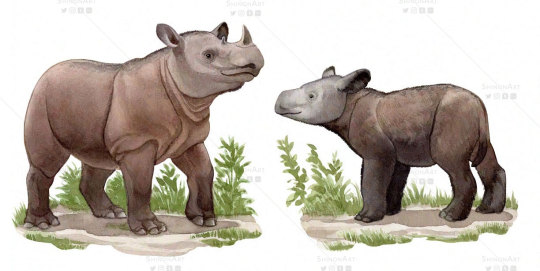
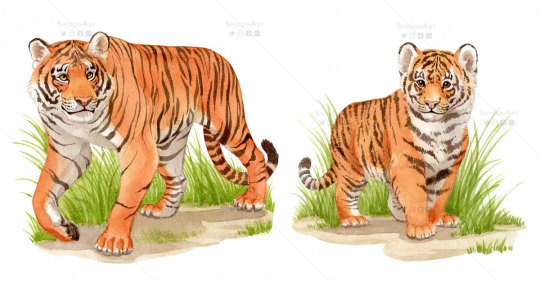
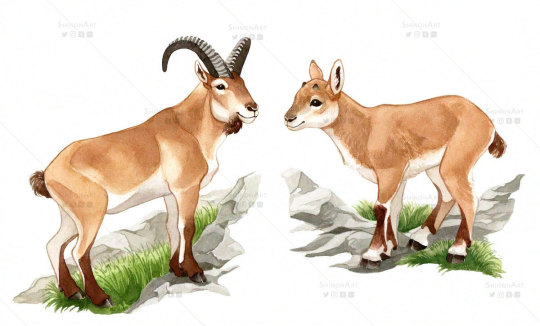

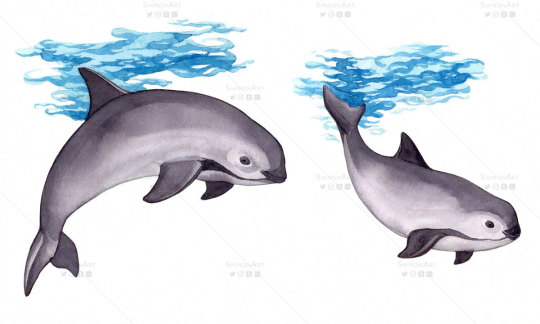
I recently illustrated a memo game "Endangered Animal Babies" for Treecer. This memo game contains 72 unique illustrations and 36 endangered animal species. Each pair consists of the parent and the baby animal and all the illustrations were done in watercolor.
I'm really grateful for this opportunity and very happy with the outcome of the game! The game is sold by WWF Finland and Treecer at the moment.
SET 1| SET 2 | SET 3 | SET 4 | SET 5 | SET 6 | SET 7
#artists on tumblr#traditional art#watercolor#traditionalart#traditional#animal art#wildlife art#primate#pygmy hippo#tiger#big cats#baby animals#vaquita#whale shark#west caucasian tur#sumatran rhino#rhino#sumatran orangutan#orangutan
166 notes
·
View notes
Photo

West Caucasian tur Capra caucasica
Observed by itallmas, CC BY
24 notes
·
View notes
Text

West Caucasian tur
By: L. Bab
From: Brehms Tierleben
1922
14 notes
·
View notes
Text

Mammals of the Soviet Union. Volume I. 1961. Illustration by Alexey Komarov.
95 notes
·
View notes
Text
Baby West Caucasian Tur
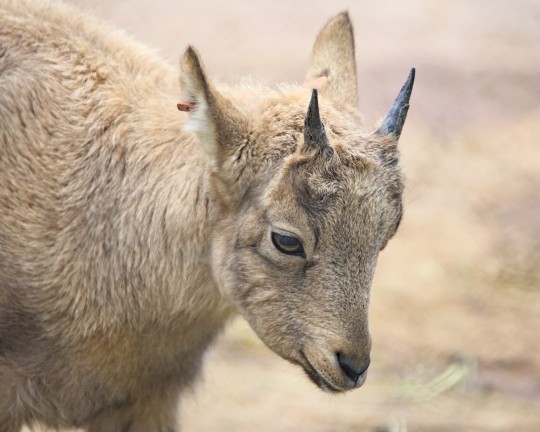
15 notes
·
View notes
Photo
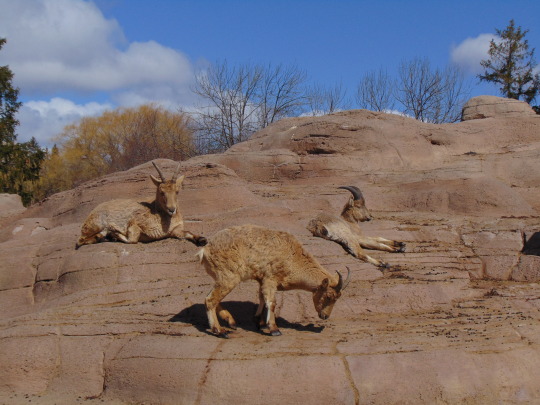

A trio of West Caucasian Tur (Capra caucasica) at the Toronto zoo.
#West caucasian tur#ungulate#bovidae#bovid#caprinae#caprini#capra#caucasica#toronto zoo#zoo photography#my pix
88 notes
·
View notes
Photo
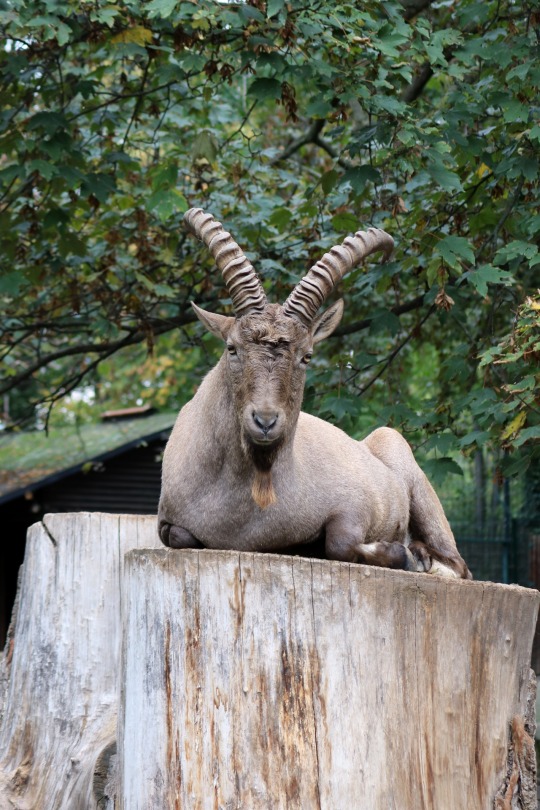
West Caucasian Tur (Capra Caucasica)
Zoo, Dresden, Germany
#photographers on tumblr#animals#ibex#zoo#dresden#germany#west caucasian tur#capra caucasica#nature#autumn#fall#vertical#original photographers#original photography
129 notes
·
View notes
Text
Six Prince Consort Monster AU
That titles a mouth full...
Here’s the Monster AU version of @redladydeath‘s Six Prince consorts spinoff, the species where chosen by her

Geoffrey - Griffon
Guildford - Hydra
Phillip - Gargoyle
William - Amphibian Man
George - Satyr
Albert - Owlman
And now for some individual analysis...
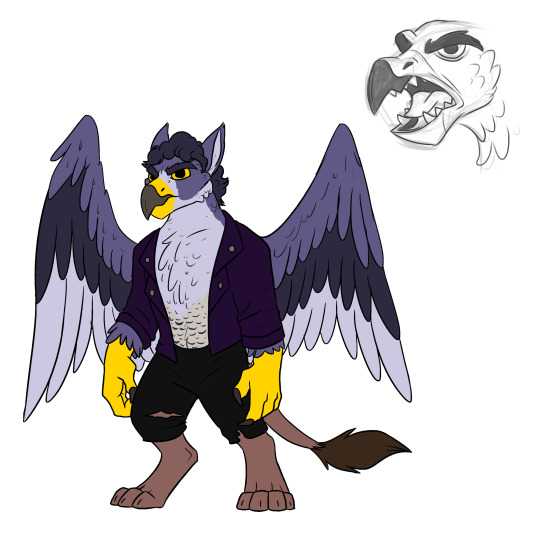
Geoffrey: His bird part is based off a peregrine falcon, but his skull is inspired by ceratopsian dinosaurs (because there’s a theory that the idea of Griffons came from a misidentified Protoceratops skull)
and yeah, he still has teeth

Guildford: He’s based off rattlesnakes, because I wanted to do something different with the tail.
And as the diagram I drew shows, his brain’s not in his heads, it’s in his chest, and is connected to all three heads. This means that his three heads don’t have different personality's, there are all extensions of the same consciousness. This is also why Hydras regrow heads so easily.
His main head is the center one and is ‘the real him’ and the one in control, he can move the rest of his body while the others can’t.
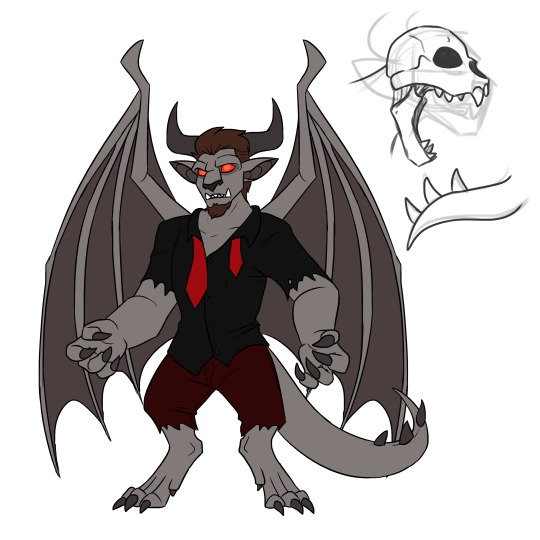
Phillip: I have my own big species profile on gargoyles in this universe. Here, gargoyles are much like elephants in terms of social structure. Females stay together in complex groups, whereas males are mostly solitary. The two sexes come together for breeding and nothing else.
Makes perfect sense for Phil here, as he spent as much time as he could away from Mary. Now he doesn’t need an excuse, it’s his nature.
Also Peyton suggested that he has a wide opening jaw like a thylacine, due to his Habsburg genes. This isn’t a normal gargoyle thing, he’s just got wild genes
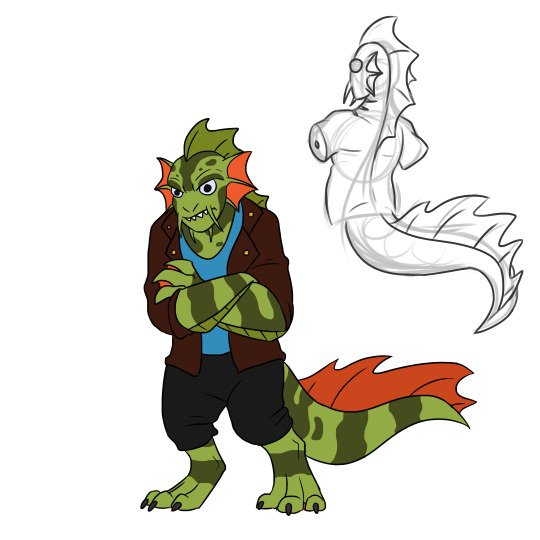
William: The least happy with his situation.
He’s like the Creature of the Black Lagoon, or the Amphibian man is you’re a Del Toro fan like me. He is basically 1/3 human 1/3 Tiger salamander and 1/3 Redtailed Catfish
This is because in real life, he was apparently a very short, ugly man and he got called ‘Caliban’ a lot (Who’s a character from Shakespeare’s ‘The Tempest’) and Caliban is usually portrayed as a gillman.
Just after William thought he was free from all that mockery, he becomes a literal swamp monster, poor guy.

George: Not much to say about George, the image kinda speaks for itself.
As the doodle says he’s pretty much full Dionysian, the wine, the partying, and now the goatness. I used a West Caucasian Tur as reference for his fur and horns.
Also in my universe Satyrs (Not fauns, don’t confuse them) are basically bonobos. The bang whoever, and whenever and are always PANsexual (geddit)
So becoming a satyr may involve gaining a satyrs all-encompassing sexual orientation. Which would be a shock.

Albert: There’s a lesser known cryptid from Britain called ‘Owlman’ it’s like Mothman! but more explicit with the Owl influence.
He’s a mix of both Barn Owl and Eagle Owl, and I tried as hard as I could not to have him look too much like Stolas from Helluva Boss, buuuuut the purple was already there.
Like Geoffrey, he also still has teeth despite being avian, and he has Amalia’s ‘wing-hands’ because archaeopteryx
#six#six prince consorts#six kings#Prince consorts of England#I don't know what this spinoff is called#monster au#six monster au#geoffrey of anjou#guildford dudley#philip ii of spain#phillip ii#william iii#william of orange#george of denmark#prince albert#griffin#gryphon#hydra#gargoyle#amphibian#gillman#fishman#amphibian man#satyr#owlman#my art#rowans art
47 notes
·
View notes
Note
Are there any particular spices of daemon whose people you think you would get along less well with?
ohhh this is such a great question thank you anon!
i’m a stubborn person and i clash a lot with other people who are stubborn but coming from a different perspective if that makes sense? i get along great with ENFJs but ENTJs, INTJs, and INFJs with underdeveloped Fe just grate on me! i don’t get along well with people who are hard-headed, self-centered, pushy, and sure they’re right. so definitely daemons who are proud and critical.
so 100% capras. the tur species, markhor, ibexes... definitely the definition of hard-headed, stubborn, and proud. i really don’t think i could tolerate being around any of these species longer than necessary, and i’m sure they’d also find me spineless, fickle, and sensitive so i think it’d go both ways. that extroversion and boldness without checking the social temperature, while also being super confident and hardy themselves... and a lot of these species aren't particularly loyal or committed which would also make me feel insecure.
the walrus also came to mind LOL like i love the concept of the walrus person in theory (assertive, bold, gregarious, confident, thick-skinned, and giving!) but i just know that we would absolutely clash in person.
also lots of birds of prey... a little too intense and ambitious for me! i just want everyone to get along. my closest coworker has a boreal owl daemon which is a more withdrawn and chill species so we get along well until she gets on her soapbox. but species like the bateleur, caracara, goshawk mb... i think i’d do well with them as more casual friends but not someone super close.
would love to hear other people’s thoughts! again no daemon-bashing at all, but everyone has people they don’t vibe with and it’s interesting to think about in a world of daemons you could quickly visually identify those people. i see a west caucasian tur and i turn right around LOL
12 notes
·
View notes
Photo

http://goo.gl/plM6ud West Caucasian tur A head shot portrait of a West Caucasian tur. by FMW51
#500px#Tiere#Saugetiere#West Caucasian tur#Hoheren Saugetieren oder Plazentatieren (Eutheria)#Stir
0 notes
Photo
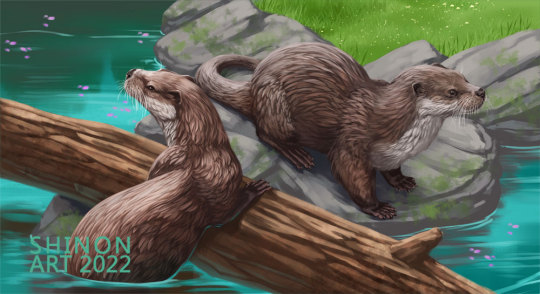
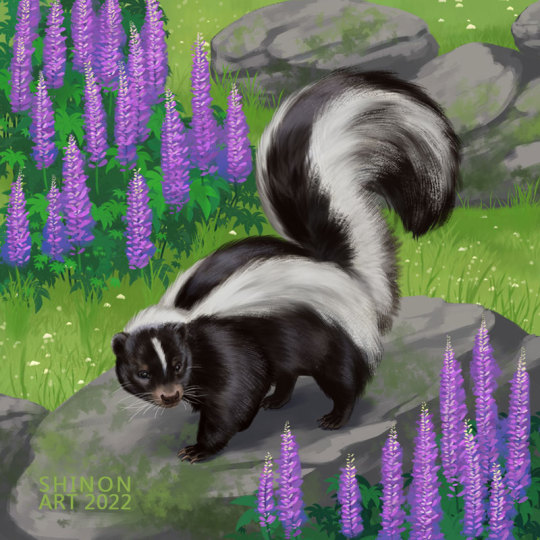


Some boreal animals I painted for Zoo Tycoon: The Board Game!
I loved the boreal colour scheme, greens, teals and purples are my jam. It was so fun to pain so many different animals - many of which I had never drawn before!
I will be posting more of the animals I painted later!
Find me and my art elsewhere!
#zoo tycoon#zoo tycoon: the board game#west caucasian tur#goat#antelope#tundra swan#swan#bird#bird art#common skunk#skunk#eurasian otter#otter#animal art#animal painting#wildlife art#animal artist#digital art#artists on tumblr
434 notes
·
View notes
Photo

West Caucasian tur by FMW51
0 notes
Text
West Caucasian tur youngster having a wee nibble
Twin babes hanging with Mom
When I first started Volunteering at the Zoo in the Fall of 2012, the Eurasia portion had been closed for a while as it underwent a bit of a facelift in conjunction with the arrival of the giant pandas for their 5-year stay. I have no idea whatsoever when I had last visited that region of the Zoo prior to its updating; when I visited as a Guest I tended to head toward Savanna for the most part, as I recall. I knew we had some red pandas (I worked an “observation shift” with two of them while Eurasia was still closed in the Fall of 2013) and was vaguely aware of there being snow leopards, but that was honestly about it. The Zoomobile drive-through began to operate in late 2013 – allowing us to view the perimeter animals of that region – but the walk-through didn’t open to the public until Spring of 2014. Volunteers and Staffers were given a few days before the Grand Opening to wander through and explore the new (or renovated) exhibits; it was sometime during those days that I first set eyes on the huge West Caucasian tur “mountain” and it was love at first sight.
A goat for all seasons
These adorable goats (some websites list them as “goat-antelopes, but that seems faulty to me) never fail to bring a smile to my face, no matter the season, in all kinds of weather. They are cute and curious, nimble and joyous. Even in the hottest days of the summer a visitor will still likely see at least a couple of members of the large extended family moving about (sometimes in the tunnel-through), eating, drinking, play-jousting, or just watching the interesting animals on the other side of their fence. Here I refer to us humans; there aren’t any good sight lines to the other species in the Zoo’s collection from the tur exhibit, although I have admittedly never stood atop their mountain. Having said that, I did experience a rather hilarious moment during the pre-opening days: while I was standing on the upper viewing platform for the snow leopard exhibit located directly across the path from the turs, I heard a bit of a mild commotion coming from the mountain goats’ exhibit. When I went to the other side of the viewing area to see what was up, I saw that many of the flock had made their way up close to the fence on the near side of their enclosure. Wondering what would have caused this reaction, I craned my neck out as far as I could and spied the catalyst: two of the Outreach and Discovery Keepers were taking a few of the Kids’ Zoo’s domestic goats out for a walk and the turs had gathered together to stare at them in wonder and amazement – and perhaps a little envy? They began to bleat at the leashed goats, but it was unclear to any of us bearing witness whether they were asking to be let out to see their cousins, or warning the “escapees” to get back into the enclosure before something happened to them. Either way, it was a delightful exchange to watch and, I am sure, is one of the reasons I took to these cute ungulates right off the bat.
Those horns are heavy, man!
But there is more to my affinity for this exhibit than just the adorable creatures who inhabit it. I am clearly not the only visitor who tends to head for the “big ticket” animals and not spend any time in the Eurasia Wilds area on a trip to the Toronto Zoo. As a result, most of this area is a lot less busy than the rest of the Zoo – something that appeals to me greatly on most days, but especially on weekends, holidays, PA days: any time the park is more crowded than usual. And as relatively quiet as the Eurasia Wilds are, the tur exhibit in particular is an absolute dream for anyone wishing to just commune with the animals of the four-legged variety and tune all the rest out. As I mentioned earlier, their space is huge. A fence completely surrounds it, so every inch of it (save for the deepest shadows of the tunnel through the south end of the mountain) is visible to the naked eye. If one is standing quietly at one part of the fencing and a group of other people comes in a little too close for relaxation purposes, it’s a pretty simple matter of moving a few dozen feet one way or the other and resuming your reverie once again. That same fencing is directly accessible by Zoo visitors on the one side and by the turs on the other, giving it the illusion of a giant petting zoo for the most part, which is aided in no small part by the cuteness dial being turned up to 11 for these lovely beasts. Obviously, it is not a petting zoo so please, if you do visit, don’t touch the turs; you likely wouldn’t get the chance in any event because as curious as they are, they still don’t tend to come within reach of grasping hands or protruding fingers. But on the off-chance they do, they are still not to be interacted with no matter how difficult it is to curb that instinct.
Hanging out in the hay feeder
There are always a lot of youngsters in the group, it seems, at various stages of development. For the first couple of years at least it is very easy for the little ones to squeeze through the bars of the two hay feeders – as you can see from the photo here at right. Actually, this little gal is the same one who appears on the May calendar page; this photo was taken a minute or two before the one that made the final cut as I had caught her dozing in the alfalfa and stayed long enough to capture her exiting the steel feeder, with one lone strand of straw hanging from her lips in true Huck Finn style. The youth will often sleep in there – and why wouldn’t they? shady, cushiony, airy… – but more often they will hop in there to obtain access to the sweet hay when the older, larger members of the flock push them out the way too many times. In all my visits to the turs exhibit, the sight of a small goat sitting in the feeder has never once failed to extract a comment or a giggle from the other people in attendance. Yes, it’s just that adorable.
Twins in the manger
As they grow bigger, the time eventually comes when the young turs are no longer able to squeeze through the bars of the larger feeders. Reluctant to admit total defeat, they usually at this point turn their attention to the trough-like mangers that are scattered about their enclosure, as you see in this photo at left. In the wild, turs tend to spend most of their daylight hours sheltering from the sun (and predators), so we are lucky to see them moving at all during normal Zoo hours…but when they are not moving they tend to fall asleep in (in my opinion) some of the most heart-melting locations and positions of any animals in the entire Zoo. A pretty large proportion of my photos – and I have taken a lot of shots of these animals – show the turs in various comic or “aw”-inspiring positions on and around their mountain. But they don’t sleep all the time – and tend to not all sleep at the same time, in any event. And it is the gentleness of their movements, the effortless and balletic leaping from perch to perch, the slow stroll they (usually) make from one place to another, it is all of this that often mesmerizes me when I visit so that time flies by without my noticing. But my greatest pleasure of all is the sound they make: the gentle tapping of their hooves on the ground; the soft “clunk” their horns emit when the turs lower their heads to the rocks; the incredibly satisfying “click-clack-click” they produce when jousting and sparring; all of these sounds and more are so relaxing and zen-like to me that these turs have rocketed up my list of most-visited species at the Toronto Zoo and are now very, very near the top of that list. No matter what kind of day/week/month/lifetime I am having, I can always rely on these wonderful mountain goats to provide me at least a few moments of respite, and I can always find a place around their perimeter to be completely alone with the animals for a while. They have become very important to me, which is those of you who have purchased my calendars for multiple years will likely have noticed an almost “disproportionate” number of pictures of West Caucasian turs in relation to the rest of the collection at the Zoo.
And for that, I make no apologies whatsoever.
Next month, I have something unusual for you: an animal that is not part of the Zoo’s collection (formally known as “non-inventory”) but the photo I managed to capture of their brood was far too remarkable to exclude from this calendar. I hope you enjoy it! In the meantime, here is some bonus footage of these wonderful Capra caucasica caucasica creatures.
2017 “Baby Boom!” Calendar – May Story When I first started Volunteering at the Zoo in the Fall of 2012, the Eurasia portion had been closed for a while as it underwent a bit of a facelift in conjunction with the arrival of the giant pandas for their 5-year stay.
0 notes
Text


Chinsanaa Baterdene as Genghis Khan of the Mongol Empire and his West Caucasian tur, Naransetseg.
Genghis Khan was born in Mongolia in 1162 A.D. and went on to create the largest land empire in human history. After uniting Mongolia’s warring tribes, he conquered a territory of eleven million square miles from China to the Caspian Sea. After his death, his descendants went on to capture territories in Europe. Though many people died during his military campaigns, he also created the first international postal service and ensured religious freedom for his subjects.
West Caucasian tur daemons represent a love for adventure, a competitive nature, and decisiveness.
#genghis khan#temujin#mongolia#mongol empire#daemons#hdm#hdmedit#history#historyedit#hdm au#medieval
5 notes
·
View notes
Photo



Khizi is the least-populous district of Azerbaijan. Its capital is the town of Xızı. It is one of the new administrative-territorial units established in 1990 by the decision of the Supreme Soviet of the Republic of Azerbaijan. The district has a remarkable variety of landscapes. On the flat Caspian coast there are irrigated cattle and chicken-breeding lowlands around Shurabad. West of Giläzi; the Xızı road climbs gently through stripily coloured semi-desert landscapes known as the Candy Cane Mountains. Around 10 km west of Xızı town; the green; heavily forested hills around Alti Agach which has been declared an Altyaghach National Park. The national park is home to the rare East Caucasian Tur; a mountain dwelling goat antelope found only in the eastern half of the Caucasus Mountains.. For you we are planning many hiking adventure tours after quarantine regime. Follow us.. #Khizi #region #Xizi #pocket_world #outdoor #campinglife
0 notes
Text
Science Studies Describe Machine Learning Algorithm to Speed Mendelian Diagnoses, Safe Drug Response Gene, More – GenomeWeb


A team led by researchers from Stanford University have developed a machine learning algorithm that can rapidly parse medical literature to speed the diagnosis of Mendelian disorders. As reported in Science Translational Medicine this week, the algorithm — called AMELIE, short for Automatic Mendelian Literature Evaluation — parses all 29 million PubMed abstracts, as well as more than 500,000 full-text articles, to identify information supporting the causality and associated phenotypes of most published genetic variants. It then prioritizes patient candidate variants for their likelihood of explaining any patient’s given set of phenotypes. When applied to 215 diagnosed singleton Mendelian patients from the Deciphering Developmental Disorders project, AMELIE identified the causative gene in 66 percent of the patients. Its developers say their tool is three- to 19-times more efficient than hand-curated database-based approaches and offer it online.
A Washington University School of Medicine-led team has identified a gene required for a patient’s safe response to nitrogen-containing bisphosphonates (N-BPs), a class of medications for bone disorders such as osteoporosis. In a study appearing in Science Translational Medicine, the researchers note that, while largely effective, N-BPs such as alendronate carry the risk of rare but traumatic side effects such as atypical femoral fracture (AFF) and osteonecrosis of the jaw (ONJ). Using CRISPRi-based genome-wide screening in cells and patients, they identify a gene called ATRAID that is required for alendronate inhibition of osteoclast function and, when knocked out in mice models of osteoporosis, impairs therapeutic responses to the drug. By sequencing the exomes of patients taking N-BPs who experienced AFF or ONJ, the investigators link differential expression of ATRAID to the side effects and poorer treatment outcomes.
By studying the genomics of different goat populations, scientists from Northwest A&F University in China have uncovered new details about the animal’s domestication. The researchers sequenced and analyzed the genomes of 164 modern domestic goats, 52 ancient goats, 24 modern wild goats, and four ancient wild goats from different locations worldwide. Among their findings is evidence of an ancient introgression event from a West Caucasian tur-like species to the ancestor of domestic goats. One introgressed locus with a strong signature of selection harbors a gene encoding a gastrointestinally secreted mucin that forms a protective glycoprotein coat involved in host innate immune responses to the invasion of multiple gastrointestinal pathogens.
Source
The post Science Studies Describe Machine Learning Algorithm to Speed Mendelian Diagnoses, Safe Drug Response Gene, More – GenomeWeb appeared first on abangtech.
from abangtech https://abangtech.com/science-studies-describe-machine-learning-algorithm-to-speed-mendelian-diagnoses-safe-drug-response-gene-more-genomeweb/
0 notes